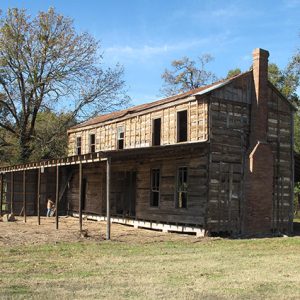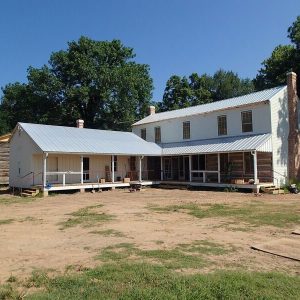calsfoundation@cals.org
Taylor Log House and Site
aka: Taylor House of Hollywood Plantation
The Taylor House, a two-story, dogtrot-style home built in 1846, is among the few remaining examples of Arkansas vernacular architecture built before the Civil War (1861–1865). Construction began in 1846 by Dr. John Taylor and his wife, Mary Robertson Taylor. The cypress-log house sits on the west bank of Bayou Bartholomew near Winchester (Drew County), a town named for the Taylors’ hometown in Kentucky, just off Arkansas Highway 138. The house was the hub of Hollywood Plantation, likely named for the deciduous holly trees that thrive along the bayou. At the zenith of the Taylors’ prosperity during the antebellum cotton boom, Hollywood encompassed some 11,000 acres, worked by 101 slaves. After the war, Hollywood successfully transitioned from slavery to free labor. The Taylors permanently relocated to Hollywood in 1876 after selling their Kentucky home, Mauvilla. The family occupied the house until the 1940s, when descendants started selling the surrounding land. The house was thereafter used to store farm machinery and duck-hunting boats.
In 2012, John Hancock of El Campo, Texas, donated the Taylor House to the University of Arkansas at Monticello (UAM) for historical research and interpretation. UAM began restoring the house and adjacent grounds to how they appeared in the earliest known photographs. Funded by nearly $1.8 million in grants by the Arkansas Natural Resources Commission, restoration was undertaken in four phases. Phase I included log repairs, exterior restoration, reconstruction of the north porch, and relocation of the original log smokehouse from Monticello (Drew County), where it had been moved in the 1970s. Phase II included the reconstruction of the kitchen ell (previously destroyed by fire), the interior restoration of the main house, and the installation of site utilities. Drew County also built a new access road for the property. Phase III built the visitor’s center, the parking lot, and more site utilities, making the property ready for public use. Plans were announced for Phase IV, including reconstructing the servants’ quarters, cistern house, chicken coop, privy, and bell tower, and creating the initial interpretative exhibits. Tommy Jameson served as the project architect, with historical consultation provided by Preservation Matters, assisted by UAM history professors Clinton Young and John Kyle Day.
Once restored, the Taylor House will appear as it does in historical photographs, taken by Colonel John R. Fordyce of Little Rock (Pulaski County) in 1914. The dogtrot is preserved, with two large rooms on the main floor serving as dining room and parlor, divided by the dogtrot breezeway, with the rebuilt adjacent kitchen ell. The second floor, accessible by the stairway located on the north side of the breezeway, served as the sleeping quarters, with two bedrooms, one on each wing of the house, connected by the hallway on the top on the staircase. The exterior is also restored, with rebuilt twin chimneys located on each side of the original structure. The manufactured whitewashed siding, as well as the interior custom wallpaper—both likely installed as gentrification measures shortly after the Taylors’ permanent relocation to Hollywood—were also reconstructed, but with one small section on the interior of the breezeway left open in order to exhibit the original cypress logs.
In the 1980s, the Arkansas Archeological Survey began research at Hollywood of the proximate Native American Taylor Mounds (circa AD 1200), which were initially documented by Edward Palmer in 1882, as well as the pre-mound middens and pits of the Baytown Period (circa AD 400–700). The Survey also conducted excavations at the house for a 1991–1992 training program. After UAM’s acquisition, archeologist Jodi Barnes of the UAM Research Station directed numerous digs around the house and outbuildings, developed a number of public outreach programs, and began restoration of nearby cemeteries. UAM announced plans to use the Taylor House as a public teaching tool, whereby faculty members can train students in historical and archaeological research, museum interpretation, and administration of a heritage site, as well as other university-related educational activities, including community projects, public history, and tourism. The Taylor House was listed on the National Register of Historic Places on October 16, 1995, and has the potential to become a popular attraction along the new Interstate 69 just a few miles to the south.
For additional information:
Barnes, Jodi A. “Archeology of Health and Healing at Hollywood Plantation.” Drew County Historical Journal 30 (2015): 18–27.
———. An Archeology of Hollywood Plantation, Drew County, Arkansas. Research Series No. 71. Fayetteville: Arkansas Archeological Survey, 2023.
———. “Citizen Archeology in Arkansas.” Journal of Community Archeology and Heritage 5, no. 2 (2018): 4–16.
———. “Tonics, Bitters, and Other Curatives: An Archaeology of Medicalization at Hollywood Plantation.” International Journal of Historical Archaeology 27 (March 2023): 81–116.
Gould, Joan, and Tommy Jameson. Hollywood Plantation: Capturing the Past, Transitioning to the Future. Little Rock: Jameson Architects, 2013.
Jenkins, Cary. “Digging for (History) Gold.” Arkansas Democrat-Gazette, September 10, 2023, pp. 1E, 3E. Online at https://www.arkansasonline.com/news/2023/sep/10/archaeological-digs-focus-on-hollywood-plantation/ (accessed September 11, 2023).
Jeter, Marvin, ed. Edward Palmer’s Arkansaw Mounds. Fayetteville: University of Arkansas Press, 1990.
Patton, Rachel Silva. “Arkansas Listings in the National Register of Historic Places: The Dr. John Martin Taylor House/Hollywood Plantation.” Arkansas Historical Quarterly 74 (Spring 2015): 78–86.
———. “The Taylor Family Cemetery.” Drew County Historical Journal 31 (2016): 17–22.
Ross, James A. “The Taylor Log House (3DR26): An Archeological and Historical Investigation of an Antebellum Plantation House in the Arkansas Delta.” MA thesis, University of Arkansas, 2001.
“Taylor Log House and Site.” National Register of Historic Places registration form. On file at Arkansas Historic Preservation Program, Little Rock, Arkansas. Online at https://www.arkansasheritage.com/arkansas-historic-preservation-program (accessed February 10, 2023).
John Kyle Day
University of Arkansas at Monticello
 Historic Preservation
Historic Preservation Louisiana Purchase through Early Statehood, 1803 through 1860
Louisiana Purchase through Early Statehood, 1803 through 1860 Taylor Log House and Grounds
Taylor Log House and Grounds  Taylor Log House and Site
Taylor Log House and Site  Taylor Log House and Site Prior to Restoration
Taylor Log House and Site Prior to Restoration  Taylor Log House; 2017
Taylor Log House; 2017  Taylor Log House
Taylor Log House 




Comments
No comments on this entry yet.